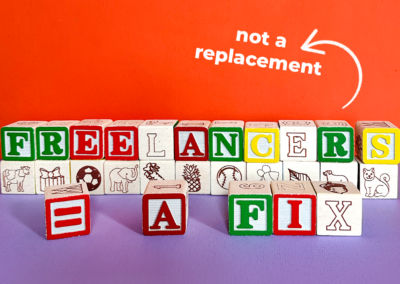Being financially literate does not come with a nest egg or a rainy day fund. It does mean, however, that you are more likely to be better equipped to deal with uncertainty because you know you have to plan for the unexpected. And if 2020 taught us anything, it’s to expect the unexpected.
A Pew Research Center study found that 19 percent of Americans have had trouble paying their bills in full since COVID and only 47 percent could cover their expenses for three months in an emergency. For Black and Latinx Americans, only one third say they could cover expenses for three months; and for those without that rainy day fund, a mere 28 percent could cover costs by borrowing money. When we as a society fail to teach the basics of financial literacy, we not only fail to protect our most vulnerable, but our entire communities also suffer.
So how do we fix this? Destigmatizing money conversations around salaries, how to ask for a raise, understanding your full benefits, and planning for future investments, is a great place to start and doing so within your organization can enhance not only financial literacy but financial equity, too.
Go beyond the old corporate training and think pragmatically:
- Offer smaller group sessions around annual tax filing workshops where employees can be informed of any updates to the regulations or tax relief options. A more intimate workshop can help provide targeted advice for any personal questions asked to professionals equipped to help, and can also provide more one-on-one support for the more confusing questions. By sending out a spreadsheet in advance with checkboxes for questions like, “Did you get married this year?” or “Did you have a child(ren) this year?” may help your work community plan and be equipped to ask the questions they need to surrounding these areas.
- Facilitate quarterly or biannual 401(k) plan discussions. Remind employees of employer contributions, if you offer that, and what that means for their contribution limits. Save some time at the end to have an informal discussion about retirement or other financial goals like homeownership and how their 401(k) can help them achieve those goals.
- Devote a Slack channel to finances where employees can share their own resources with each other, suggest accountants, or wealth management tips. It is small acts like these that reinforce how accessible money conversations can and should be.
- April is Financial Literacy Month — gamify it! For example, with your team or organization, share a word of the day taken directly from Investopedia’s Dictionary’s Term of the Day newsletter and give points to whoever gives the best explanation, and offer gift cards as a reward. It’s a judgement-free way to get people involved while expanding their knowledge. And side note, you don’t have to wait until April to encourage financial literacy!
COVID-19 has heavily impacted economic activity. It has also come with a list of otherwise unavailable deferral options and changes to contribution limits. If there was ever a year to have a broader conversation in the workplace about finances, this is it.
And then there is the more controversial pay transparency approach. Pay or wage transparency is when you share, either internally or externally, specific salaries or pay ranges. It is a growing trend for companies and job posting platforms alike, but it is not without its controversy. For those that argue against pay transparency, the most often cited claim is that it can cause tension within companies and jealousy between coworkers. I would argue that the cloaked in mystery, never-show-your-cards attitude towards how much you earn is a tactic that protects companies more than employees, and at least one CEO would agree.
Speaking with Stephen Dubner on a recent episode of Freakonomics, John Mackey the CEO behind healthy-food retailer Whole Foods, gave some credence to the envy argument but explained why they’ve taken the opposite approach.
“When you reveal a pay structure very transparently — first of all, sometimes things aren’t just. And people will complain about it. And that gives you an opportunity to correct it. At other times, though, it is correct, and you can defend it. And then you’re pointing out to people what the organization most values and rewards. And it gives people something to strive for.”
If you visit the Whole Food careers page, you’ll see the average pay for different positions. It is worth noting that they have, however, decided not to extend wage transparency to their corporate jobs.
While Mackey doesn’t explicitly refer to pay inequity as the thing that may need correcting, it would certainly fall into that category. Pay equity is a very natural extension of sharing wages in an open and transparent way, and it applies to more than the individual. If managers could see that other departments were receiving larger budgets for new hires or projects, those decisions would need to be explained. If employees with soft skills — which are tied to higher levels of emotional intelligence (EQ), one of the strongest leadership skills — are paid a fraction of what employees with hard skills are making, people will speak up.
It’s important to remember that wage transparency doesn’t mean that everyone earns the same amount or that gone are the possibilities of promotions or pay increases. This type of transparency holds management accountable for their financial decisions as they relate to hiring and employee salaries and, whether explicitly or implicitly, signals to employees that conversations about money aren’t off the table and that the topic isn’t taboo.
As leaders in the field or of organizations, taking a more community-minded approach to finance trickles down. Conversations between managers and employees can make conversations between colleagues and friends easier. Those conversations and the learnings can be shared with children. Having conversation early on not only normalizes money, but normalizes having questions and concerns about it too. If that’s a trend we can work on collectively, financial literacy rates may evolve into more of an asset than a liability.
—
Test your knowledge with the Wall Street Journal’s Financial Literacy Quiz
Carly’s Socials: Linkedin, Twitter
Editor’s Socials – Dominque Dajer: LinkedIn, Twitter, Instagram



